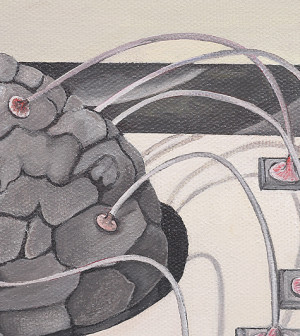- Navigating Your Midlife Crisis: Embracing New Possibilities
- City Raccoons Showing Signs of Domestication
- Mapping the Exposome: Science Broadens Focus to Environmental Disease Triggers
- One Week Less on Social Media Linked to Better Mental Health
- Your Brain Changes in Stages as You Age, Study Finds
- Some Suicide Victims Show No Typical Warning Signs, Study Finds
- ByHeart Formula Faces Lawsuits After Babies Sickened With Botulism
- Switch to Vegan Diet Could Cut Your Greenhouse Gas Emissions in Half
- Regular Bedtime Does Wonders for Blood Pressure
- Dining Alone Could Mean Worse Nutrition for Seniors
Zika Babies May Look Normal at Birth, Display Brain Defects Later: CDC

Babies exposed to the Zika virus in the womb can look normal at birth but later show signs of the devastating birth defect microcephaly and other brain abnormalities, researchers reported Tuesday.
Scientists found that 13 infants in Brazil who were exposed to the mosquito-borne virus during gestation had normal head size as newborns, but subsequently experienced slower head growth.
Eleven of these babies were diagnosed with microcephaly — an abnormally small head and brain — and other neurologic complications associated with Zika syndrome, the researchers reported.
“Among infants of mothers exposed to Zika virus during pregnancy, the absence of microcephaly at birth does not rule out congenital Zika virus infection or the presence of Zika-related brain abnormalities,” according to a news release from the U.S. Centers for Disease Control and Prevention.
The findings from the U.S. and Brazilian research team underscore the need for continuing evaluation of newborns with possible Zika exposure during pregnancy, the CDC release said.
The findings also highlight the “importance of early neuroimaging for infants who were exposed to Zika virus prenatally,” the agency added.
Although these babies all tested positive for Zika exposure in the womb, abnormal head growth wasn’t detected until at least 5 months of age, according to the report.
The findings were published Nov. 22 in the CDC’s Morbidity and Mortality Weekly Report.
More details on how the Zika virus affects infants and adults will be presented to international researchers meeting in Chicago next week.
Most cases in the current crisis have occurred in Latin American countries. Three new studies from Brazil are scheduled for presentation at the annual meeting of the Radiological Society of North America.
In one study, researchers used CT imaging to examine the central nervous system of 16 newborns whose mothers were infected with Zika during pregnancy. The babies were found to have a number of brain abnormalities.
“Our study proves that Zika virus infection can cause congenital brain damage in babies with and without microcephaly,” study author Dr. Natacha Calheiros de Lima Petribu said in a society news release. She’s with the department of radiology at Barao de Lucena Hospital in Recife, Brazil.
In another study, researchers used MRI to assess Zika-affected adults and infants with neurological disorders. Pregnant women with rash outbreaks suggestive of Zika also underwent MRI screening.
Although most Zika-infected adults experience only mild symptoms such as fever and rash, some have developed Guillain-Barre syndrome, a rare disorder involving severe muscle weakness.
Many of the adults in this study had changes to certain spinal and facial nerves. Some had inflammation of the brain and spinal cord, or brain stem and spinal cord lesions. The infants showed brain structure abnormalities, the researchers found.
“It was alarming to find so many cases of neurological syndromes in adults, some very serious, related to Zika virus infection,” study author Dr. Emerson de Melo Casagrande said in the news release.
“We have also noticed a difference between these syndromes, even though the trigger was the same,” said Casagrande, who is in the radiology department at Antonio Pedro University Hospital of Federal Fluminense University in Niteroi, Brazil.
In the third study, researchers conducted ultrasound and fetal MRIs on Zika-infected pregnant women at different stages of pregnancy.
After birth, the babies underwent ultrasound, CT and MRI imaging. More than half the infants had microcephaly, brain calcifications, loss of brain tissue volume, and other brain structural abnormalities, the researchers found.
“The emergence of Zika virus in the Americas has coincided with increased reports of babies born with microcephaly,” said study author Dr. Heron Werner Jr., of the radiology department at Rio de Janeiro’s Clinica de Diagnostico por Imagem.
“An early diagnosis may help in treating these babies after birth. Moreover, the knowledge of abnormalities present in the central nervous system may give hints about the pathophysiology of the disease,” Werner added.
The radiological meeting runs from Nov. 27 through Dec. 2. Research presented at meetings is usually considered preliminary until published in a peer-reviewed medical journal.
More information
The World Health Organization has more on Zika.
Source: HealthDay
Copyright © 2025 HealthDay. All rights reserved.










